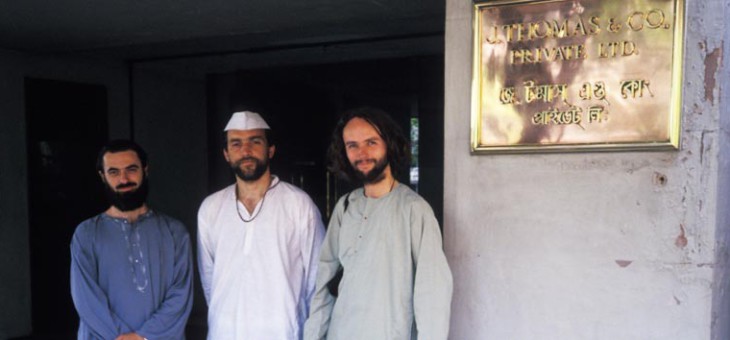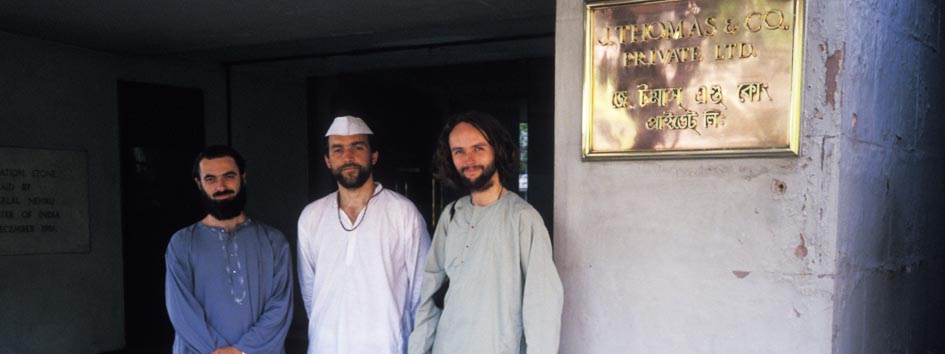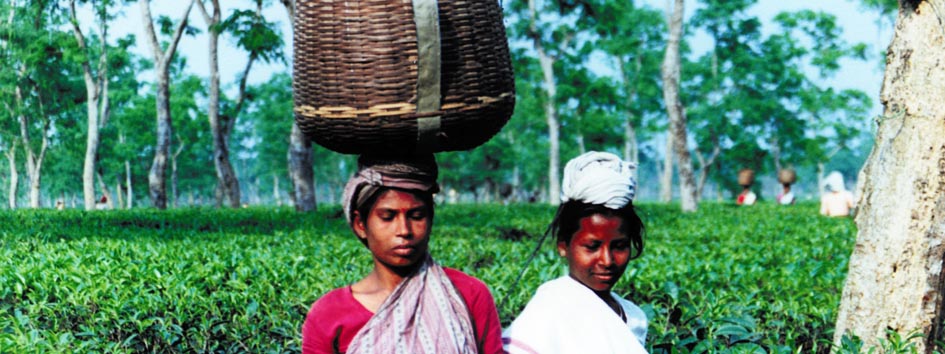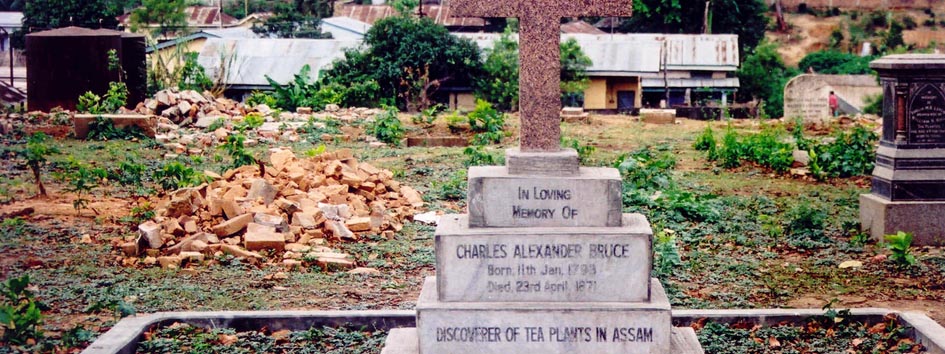
Journeys through Assam and Darjeeling, 1995 and 1999.
I can’t explain why, but every time I leave India I say to myself, “Never again!” Perhaps it’s because I’m always so exhausted when I return home. When I travel on my tea discovery journeys, my tea instinct almost always takes me to places that are unknown to foreigners – places that have little in the way of creature comforts.Yet despite my past “resolutions,” here I am flying to India for the fourth time, once again of my own free will and again in the hope that this beloved land with its oceans, great mountains, unending sun-baked plains, crammed railway cars, people shining with the bright flame of faith and above all some of the best teas in the world, will hold no grudges against me and be generous to me. It has always been so in the past. It has always given me my share of deep experiences. And during the ten-hour flight I keep going back over those experiences in my head, and I’m a little nervous. I don’t know what is waiting for me.
Faithful to the Legacy of Mahatma Ghandi
I first visited India with friends in 1995, in the foolish hope that in the virgin forests of the East Indian state of Assam we would track down the wild tea plant found there in 1823 – so we had read – by Major Robert Bruce. We were fascinated by the idea of following in the footsteps of the old discoverers right up to the border of what is Myanmar today, and traveling from the then unknown settlement of Sadia, where in 1826 Sir Charles Alexander Bruce founded the first tea plantation, downstream along the life-giving River Brahmaputra as far as Calcutta. After all, it was in Calcutta that Assam tea was first loaded onto a boat bound for England, so that in 1839, in a London auction house, Englishmen could sell the first tea cultivated on the territory of the British Empire.
In 1995, Assam was one of the few territories in India to which a foreigner could not travel without special permission. Such permissions were issued “in tandem” by two institutions, namely the Ministry of Home Affairs of India and the Office of the Resident Commissioner, Assam House, both located in New Delhi.
Anyone who has ever been in India knows all too well that Indian officials give a whole new dimension to the word “bureaucracy.” We four friends and tea enthusiasts went back and forth and back and forth through the streets of New Delhi hoping that even if an official at the Ministry had put us off ten times, we would be successful on the eleventh attempt. We also somehow believed that the bureaucrats in the Office of the Resident Commissioner would be more forthcoming when they saw our faces at the application window for the fifth time. Oh how naive we were! We got absolutely nowhere.
In the end there was nothing left for it but to use Indian weapons to get results. On our unending trips across the city we were fascinated by the traditional costume worn by some Indians and we decided to try it out ourselves. We bought ourselves long shirts and loose trousers made of natural material and I even acquired a boat-shaped white cap. When I first put the whole outfit on and went out into the streets I was surprised to find people pointing at me, clasping their hands in gestures of greeting and addressing me as Papa Nehru. And then it came to me that I might be able to use the effect to my advantage. I thought of the non-violent way in which one of the greatest figures of modern Indian history, Mahatma Ghandi, managed to achieve his aims. So we donned our traditional Indian costumes and set off for the Ministry. Once again they welcomed us with “poker faces” and ignored us. But then we sat down on the floor in the lotus position and announced that we did not intend to get up again unless and until the permissions were issued, and we were starting a hunger strike. The permissions were in our hands within five minutes.
They did, however, leave us with one warning. “Avoid the town of Jorhat! It really is forbidden to foreigners,” the official said. But how we were going to avoid the town of Jorhat when it contained the headquarters of the Tea Research Institute of Assam? We had no idea, but it seemed best to ask no questions and just get going.
Is Paradise Green?
We spent thirteen hours on an Indian train in a car that had no doors and so there was no way of stopping the unending succession of hawkers of all kinds who kept coming in to offer underwear, umbrellas, nail clippers, polish for shoes or the removal of facial and nasal hair; naturally we were tired and rather nervous. To make matters worse the train was six hours behind schedule, but still the conductor tried to observe the only element of the time-table under his control – hourly waits at each station. We reached the most remote place of our journey, the town of Tinsukia, exhausted, and in total darkness.
A wonderful surprise awaited us the next morning. The sight of the boundless Assam tea plantations full of women pickers with timid doe-eyes, the sound of the unending silence that reigns there, interrupted only by birdsong and the rustle of the tea leaves, truly an unforgettable experience.
We hired some cycle rickshaws and off we went. The Chotta Tingray Tea Estate, the first plantation we visited, is one of dozens where tea is processed using the C.T.C. (crushing, tearing, curling) method. It is a method that gives a balanced, consistent and strong brew. The crushing of the stalks and sometimes even parts of the branches adds a special woody flavor. The tea characteristically releases its color and taste very quickly after steeping, and is ideal for blending with milk or spices.
We enjoyed the views of the green ocean, and continued downstream along the Brahmaputra hoping to have a chance to find wild tea bushes in the forest. This was the way that the Bruce brothers sailed on a barge a hundred and sixty years ago, struggling through impenetrable malarial swamps to discover the wild tea trees. Today, however, there is no wild nature left to discover any more. The Brahmaputra Valley is one of the most intensely cultivated areas in India. As remains of the original vegetation can no longer be found anywhere except in nature reserves, we made our way to the Kaziranga National Park.
As we settled down in the train, we realized that we would have to go through the forbidden town of Jorhat. As it is the seat of the Tea Research Institute of Assam, we knew we could find experts there who would tell us where to find what we were looking for. It was definitely worth the risk.
In Jail in Assam
Unfortunately we were intercepted soon after leaving the train station, loaded into military field vehicles, transported humiliatingly across the town and locked in detention cells. Time passed and every so often we were interrogated. We explained for the hundredth time why we had come to the town; for the hundredth time we were told that we shouldn’t have done so. We finally learned that we were being kept in cells for our own protection! Apparently armed groups of local extremists were operating in the area. They saw wandering foreigners as potential hostages to be used to secure the release of their fellow combatants from prison. Finally we understood. We signed a declaration stating that the next day we would leave town on the first train and we were driven to a hotel where we went to bed, protected by an armed guard.
No Help from Scientists or a Rhinoceros
Before we left we had a chance to visit the institute. There were tea bushes growing “wild” because nobody was pruning them, but little help as to where to find wild tea trees in the jungle. We left Jorhat and rode into the Kaziranga National Park, which lies on the route to Guwahati, the main city of the state of Assam. Not even on this leg of the route did we see genuine virgin forest. On the back of an elephant and accompanied by a one-horned rhinoceros we made it into genuine wilderness, but just when we were starting to cheer and hope that the real adventures were beginning, we were brought up short by a warning notice. We had reached another prohibited area where a soldier with a loaded machine-gun did not look as if he was interested in discussing the reasons for our visit. We turned back. Who could we ask for information? We looked at the rhinoceros, but he pretended he didn’t understand. Maybe some other time – or some other place?
The Grave of Charles Alexander Bruce Rediscovered!
We were on the bus that was to take us over the bridge across the Brahmaputra and I was bursting with excitement thinking of the great shots and camera footage. The other bank was so far away I couldn’t see it. I’d never been across such a wide river. Looking out the window I saw guarded booths at the end of the bridge and I remembered that just a few years after the Second World War in Eastern Europe they still used to guard strategic bridges to prevent sabotage. Such guards could be seen in the Soviet Union as late as the Seventies. But why here? To prevent people from taking photos of the water in the river?
Although I knew that photography was forbidden, I still took some photos and video footage. We were so far from the guards, how would they ever know? But the other Indian travelers on the bus, who in these remote areas have little experience with foreigners, betrayed me at the other end of the bridge! I had no choice but to pull the film out of the camera and give up the cassette from the video camera. Damned bridge!
The next town, where we didn’t really know what we were looking for, was called Tezpur. We didn’t intend to spend much time there, but our instinct made us walk around. Suddenly we saw the half-crumbled wall of a cemetery. Very strange – they burn corpses here, don’t they?
We soon realized that this was the grave of Sir Charles Alexander Bruce, who discovered wild tea bushes in Assam more than 170 years ago! Time did not stand still here, and this was no longer a place of piety. The grave in front of us was the center of a lively scene: a band of local youngsters playing cricket and the ever-present holy cows. The grave of Bruce, the man at the origin of tea-cultivation that was now one of the biggest sources of income for the government and hundreds of thousands of people in this part of the country, was now simply part of everyday life in this village! The local people honor him by pursuing their daily lives around him. For once, a great man’s monument has not been pushed to the periphery of life.
The Spring Tea Races of Darjeeling
A few years later, in 1999, I flew into Netaji Subhas Chandra Airport in Calcutta to meet an Indian friend who had invited me to a very important event. Every year at the end of March, the time of the first harvest of tea leaves known as First Flush, the bosses of the tea industry in the Darjeeling area get together for a tasting that takes place at the celebrated Planters Club in the town of Darjeeling.
I met my Indian friend Bhairav on my first visit to India at the Tea Exchange of the J. R. Thomas Company. I was drawn to him from the beginning, with his enthusiasm for tea and his spontaneous openness as he introduced me to the secrets of cultivating, processing and selling tea.
He explained to me the routes by which tea leaves get from the tea gardens to the teapots of customers and revealed more than one “trade secret.” I learned that it is common practice for many foreign tea importers sign contracts for the purchase of tea without having a chance to taste the final product. When the contracts are signed the leaves are still on the plants! I understood when it was explained that some of the tea contracts were destined for tea bag blends. However, I was surprised that this was also a common practice for leaf teas presented in shops as “single estate.” I gathered that this sad reality was the result of the ridiculous race to be the first to import the fresh First Flush spring tea, which means that quality tends to be relegated to second place. The first First Flush available, may therefore not always be the best.
Snow Leopard, a Presumptuous Attempt to Make White Tea in Darjeeling
Bhairav and I stayed in the middle of a marvelous tea plantation in a bungalow belonging to his parents near the small tea-processing factory. One day, I got the idea of preparing a little surprise for the bosses of the Indian tea industry.
Drawing on the experience I had acquired on visits to China, I decided to try and produce a new type of Indian tea, by using a hand technique tried and tested for centuries. It was supposed to be a white tea, because in China white teas (such as Bai Mu Dan) are processed in this particular way, which involves kneading the leaves and drying them on flat bamboo baskets. I asked for a sufficient quantity of fresh tea leaves, and one morning, braving the incredulous looks of the managers of the tea factory and all their employees, I put my hand to the task. I divided the tea leaves into several heaps of the same size, which I then left to wilt partially in the sun and partially in the shade. After the wilting I kneaded some of the leaves thoroughly by hand (for about 30 minutes), and some I merely shook on a bamboo tray. The fermentation took place both in the sun and on the cool floor of the fermentation room.
I dried the tea on the pipes that conducted heat to the assembly line machine dryers. The result was surprising. None of the samples was really bad. One of them even won me praise from the director of the factory, Bhairav’s mother, and from the tea production manager, who together with his deputy had been giving me the strangest looks all day as I pursued my peculiar enterprise.
This processing method definitely made my sample a white tea, and therefore unique in India. For that reason I thought that my best sample might be accepted to compete with the elite teas that would be tasted the following day in the famous Planters Club in Darjeeling.
As I was looking for a name, I heard a commotion, the voices of villagers outside the factory gates. The villagers had found a dead snow leopard among the tea plants, an animal hardly ever seen in the area, and they didn’t want to hand it over to the local authorities. Indian law makes it compulsory to report the finding of a dead protected animal, and to hand it over to special laboratories for scientific examination. An animated discussion took place, as local villagers prized ornaments made of leopard fur, as well as amulets made from the leopard’s teeth or claws which for them have a value that goes beyond that of purely decorative ornaments.
There was the name I had been looking for. The tea would be called Snow Leopard!
Yes, It’s a Good Direction …
The tasting at the Darjeeling Planters Club is a very prestigious event, but not a competition. It is up to the tea producers to select which tea samples they wish to submit and what to make of the comments they receive from the leading experts of the Indian tea industry.
However, in the throngs surrounding the tasting elite there are tea traders, brokers and representatives of foreign companies who are there to carefully note the experts’ comments on particular samples and who will adjust their buying plans accordingly.
Then came Snow Leopard’s turn. It stood out just by the size of its leaves, up to twice the size of the leaves in the other Darjeeling samples. The infusion was yellow-orange and as the scalded leaves unfolded there was no doubt left that only the two tip leaves and a bud had been used to produce it. Before the presentation I had asked Bhairav not to tell anyone who was responsible for this piece of presumption, and if anyone asked just to say that it was a white tea, hand produced using an old Chinese method.
In fact, after the experts had tasted the tea, they expressed an interest in the details. But they learned no more than had been agreed between Bhairav and myself in advance, and that wasn’t much. Yet their verdict was unambiguous: “Yes, it’s a good direction you’ve set out in!”
The Best Laid Plans!
The rest of my stay in India, Bhairav and I dreamed and talked about how we would introduce the production of white tea into Darjeeling, how we would dust off the old Chinese method for producing it and how one day we would be famous thanks to Snow Leopard. We had no idea how fast things would soon be going downhill.
Blissfully unaware, I went home to Europe and Bhairav left for studies in the United States. Soon after, my friend’s family plantation got into financial difficulties and the decision was made to sell it off. The birthplace of the Snow Leopard became a source of grief and anxiety among local people who had relied on it for their livelihood. Bhairav finally decided to marry in the USA and not return to India. The tie had been broken.
Although my activities had in no way been responsible for the problems with my friend’s plantation, I remembered my earlier presumption with a certain embarrassment and wondered if someone like me had the right to interfere in established systems that worked reliably and had been tried and tested down through the centuries. But mostly I was sad, because I was sorry for all those people I had gotten to know during my stay among the tea gardens. I had no news and wondered how hard things were for them.
Long Live Indian White Tea!
Three years later I was standing in our tasting room looking at new samples of First Flush that had reached Prague by courier from a whole range of Darjeeling gardens.
On the agenda there were more than forty samples of India teas, each submitted to us for a blind taste test with no details on exact specifications and origin. As I was assessing the look of the dry leaves, I noticed one sample whose leaves looked different from all the others.
Our team judged this sample to be one of the best. After we exchanged notes, its detailed specification was a surprise. Instead of the expected initials “SFTGOP” (Super Fine Tippy Golden Flowery Orange Pekoe, the very best of traditional black teas), were the words: “White Tea”!
Although the leaf appearance was different, the tea had a taste profile similar to that of First Flush Darjeeling teas. Our suppliers were not very forthcoming about how that particular lot had been processed. Some tea secrets must still be discovered! We still do not know whether it had actually been processed using the Chinese “White Tea” technique, if it was improperly labeled or if the supplier was simply using the name on a conventional First Flush (an infusion of First Flush gives a pale, golden colored brew) to capitalize on the growing popularity of Chinese “White Tea” abroad!
We have, however, just recently received samples of Darjeeling “White Teas” which have both the leaf appearance and a taste profile that, although less subtle, is still close to the “White Teas” from the Chinese province of Fujian. Maybe one day there will be “White Tea” from Darjeeling on the Menu of our Dobra tea rooms!




